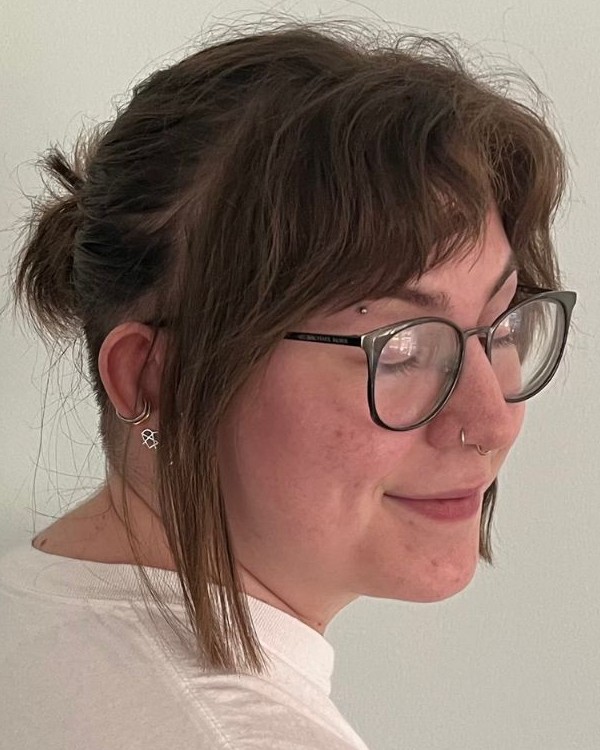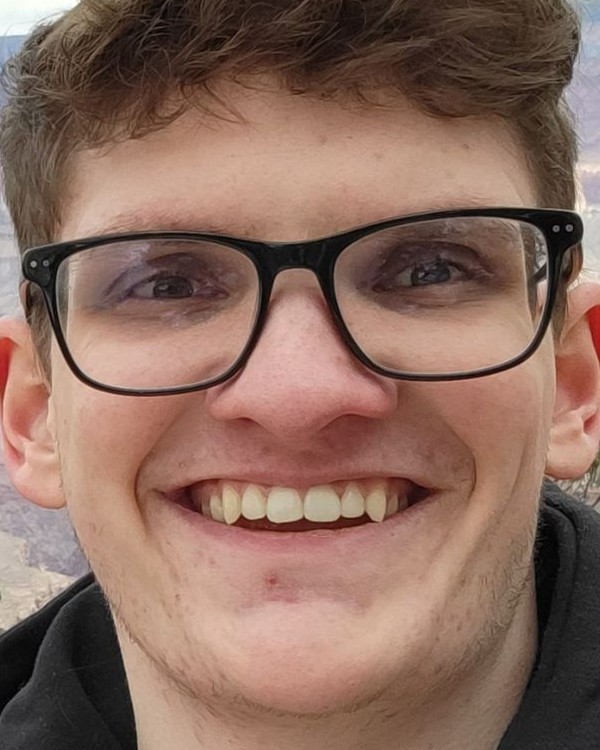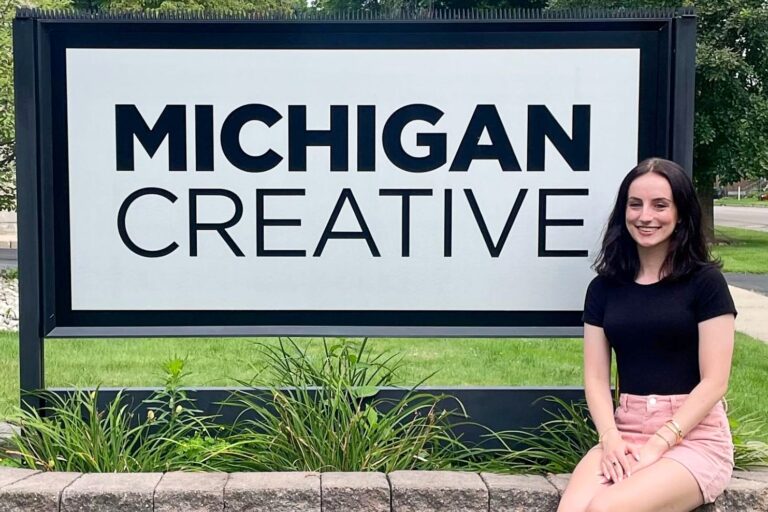Encouraging critical engagement through art with the past, present, or future, the CREATE! Microgrant program recently awarded $500 grants to 13 Michigan State University students to fund their proposed creative projects, which represent a variety of disciplines and mediums, including poetry, painting, music composition, screenplay, and sculpture.
Offered by MSU’s College of Arts & Letters and facilitated by the Dean’s Arts Advisory Council (DAAC) with support from the MSU Federal Credit Union and departments across the university, the CREATE! Microgrant program offers students the opportunity to creatively explore current events and issues through mediums such as art, dance, film, poetry, and song.

Students who receive the grants spend the fall semester creating their proposed projects. At the end of the semester, their completed works are showcased online in the CREATE! Microgrant exhibition.
“After everything our community has been through and continues to go through, we look to arts for healing and artists to help us make sense of and reflect on our world,” said Peter Johnston, Co-Director of the CREATE! Microgrant Program and Department of English faculty member. “To see the opportunity this grant can make for our student artists/writers/musicians, and the work that springs from that opportunity, is to remember why we do this in the first place.”
2023 CREATE! Microgrant Winners

Rose Butler-Shriner
Rose Butler-Shriner, an English major with a concentration in Creative Writing, will write a poem, titled “Ars Poetica: Just a Poem,” about the inability to focus on mental health and the mantras of hope people repeat in order to carry on with the lifestyle they want to maintain.
“MSU has gone through a horrific time during the last few months, one that I believe we have not had time to process fully,” Butler-Shriner said. “When I began writing this poem, I wanted to capture the importance of having hope in a time where we do not have genuine time to process. I wrote to figure out how I would process the kinds of things that we are not given time to process. I wrote to process. I wrote to heal. I want the students who go through these motions to know there is a way to use hopefulness as a coping mechanism, even temporarily, even as time passes.”
Cam Carmichael

Cam Carmichael, a Studio Art major with minors in Comics and LGBTQIA Studies, will create an oil-painted self-portrait depicting himself as a transgender person living in today’s political climate.
“Through self-portraiture, I will explore my identity of being transgender and having an abortion post-Roe, and how I can feel uncomfortable and uneasy in some climates due to my identity,” Carmichael said. “When it comes to using art as a response, I find the making process cathartic and the act of showing such work liberating. Discussions based on these issues open educative opportunities for those who are privileged to understand people like me.
“I look towards inspirations that make me happy. I’m grounded by always choosing joy or fun when making, such as glitter or fun colors, while still holding the topics of the painting there. Individuals in my generation may be too fixated on telling such stories or political practices, but they forget the fun and whimsy of exploring one’s happiness.”

Rachael Grain
Rachael Grain, a Studio Art major with a minor in Business, will create an oil painting depicting the relationship between parents and children and the generational trauma that surrounds that.
“Through the use of particular images, paint applications, and found materials, I aim to speak to the intimate relationship between parents and children, the way we treat and mistreat each other, and what we pass on to the next generation,” Grain said. “My past and planned bodies of work capture the hushed conversations of families, the heaviness of generational trauma, and the guilt we feel to protect those we love.
“Seeing how humans, nature, and animals interact with each other inspires me to make pieces about their relationships. I believe that individuals can keep creative practices by creating as much as they can. We shouldn’t rely on bursts of creativity to start a project but rather should just always start creating.”
Samantha Gucwa

Samantha Gucwa, a Jazz Studies major with a focus on Saxophone, will create a five-track album celebrating women who sacrificed their careers for their partners. The album will explicitly reference the five long-term relationships of Miles Davis with Cicely Tyson, Bette Davis, Frances Taylor, Jeanne Moreau, and Juliette Gréco.
“Miles Davis is one of the most celebrated jazz musicians in history, with students of every instrument studying his recordings,” Gucwa said. “What we do not talk about, though, is how the women in his life made his long and influential career possible. All of these women were highly successful artists in their own right who were forced to adjust or pause their careers for Davis.
“The jazz community has taken huge strides in recognizing early musician women, but we often fail to recognize that many jazz musicians thrived because of support from women who modified or sacrificed their careers for their musical partners. This album seeks to celebrate the accomplishments of these five women and open a larger conversation about the importance of non-musicians to the jazz community.”
Doug Mains

Doug Mains, an English major with a minor in Linguistics, will create a collection of poetry and non-fiction prose, titled Ready, Aim, Whisper, that explores the intersection between Christian Nationalism, gun violence, fundamentalism, and displays of traditional masculinity.
Through this work, he will consider questions such as “How did gun violence and nationalism become so synonymous with American Christianity? How might we respond to the echoes of gunfire and the relentless bellowing oppression of Christian Nationalism?”
“As a quiet child with instincts counter to the expectations of my fundamentalist Christian family, I learned to channel my inner world through the written word. I recall breathing a sigh of relief at the realization that I could tuck pieces of myself away in artistic ambiguity. Today, I continue to rely on creative writing as a safe space to explore and maybe even understand just a fraction of this vast and crazy world.”
Faith Nhkum

Faith Nhkum, a Microbiology major with a minor in Comic Art and Storytelling, will create a multimedia piece to bring attention to the genocide of the Jinghpaw people in Myanmar.
“I hope to use charcoal as my main media and maybe a watered-down red paint to represent the silent atrocities happening in my country of Myanmar,” Nhkum said. “I want to draw a Jinghpaw woman in her traditional attire. In the background, I will draw people walking by to show how the world turns a blind eye to some of the atrocities that are happening, such as the number of kids without parents.
“This war for our rightful land has been going on for more than 10 years now, and I hope with this artwork I can bring attention to what is happening in Myanmar. We are but a few people but our faith in our people is strong.”
Lauren Rake

Lauren Rake, a Film Studies major with a Theatre minor, will write a satirical comedy and dramatic screenplay addressing the isolation that can come with wanting to become a facet of the online community.
“Some of the themes in my screenplay will be the sense of isolation, loss of human connection, and the opportunity cost of spectacle online,” Rake said. “I think the loss of human connection has left many people feeling isolated and has made it easier to trade in that connection for attention and spectacle. It has become an addiction to technology, and people will go to strenuous lengths to become part of the spectacle, even if it disadvantages others.
“I wanted to write a screenplay because I can document the world I see, flawed and all. It helps me tell the audience a story that shows them this world from my point of view.”
Jesse Mae Rayer

Jesse Mae Rayer, a Public Relations major with a Creative Writing minor, will create a literary work blending two genres: horror fiction and narrative nonfiction that will explore how art can function as an accessible and essential form of therapy, touching on themes of art as a method of understanding community, gun violence, and shared trauma.
“I believe all art is documentation,” Rayer said. “Even if you don’t intend to document this moment, your life, etc., you’re doing it anyway. Not in a ‘This pottery sherd is going to change the world’s perception of ancient yeast biology,’ but in a ‘Your language, context, expectations for your audience, and everything you do in your art creates a documentation of your life’ kind of way.
“My creative practice is a habit, writing every day, whether I like it or not. Twenty words or 20,000 words — good or bad. Forcing myself to put effort into the things I love keeps me stable.”
Danny Sesi

Danny Sesi, a Music Performance major, will create a musical composition addressing religion, attentiveness, and removing all “worldly cares” as mentioned in music compositions from the Eastern Orthodox Christian Liturgy.
“Music is a constant,” Sesi said. “No matter how tough times get, people will always gather at a symphony hall and enjoy the rich musical traditions bestowed upon us. It brings people together by sheer beauty and sublime meaning.
“Outside of the strictly art-centered communities I am a part of, I am first and foremost an Orthodox Christian. In the Orthodox Church, all art is important. It is vital to our worship. Visual arts are seen in our rich iconographic tradition, and music is always a part of our services. There is no Orthodox liturgy that is merely spoken; everything is always sung. Because of this, music is not merely some nice extra thing in the Orthodox community but rather a constant reality in our striving toward God.”
Mackenzie Sheehan-D’Arrigo

Mackenzie Sheehan-D’Arrigo, a Studio Art major, will create a sculpture of a budding plant walking on its roots to symbolize the budding potential of younger generations and the challenges they face as they enter adulthood.
“This work will address issues concerning rapidly rising inflation without increased wages, a disparity that plays a large role in the anxiety faced by younger generations to find stable and affordable long-term housing,” Sheehan-D’Arrigo said. “The buds of the plants represent the potential for our society when run by today’s young adults. The plant type will remain unidentifiable and abstract to limit categorization while still focusing on the inherent mystery and liveliness of nature. The sculpture symbolizes persistence and importance, and the colors will fade from muted and matte to bright and natural to emphasize regrowth and healing.”
Theo Van Hof

Theo Van Hof, a Political Theory and Constitutional Democracy major with a minor in Creative Non-Fiction Writing, will write a poem focusing on the unfulfilled promises that come with the attempt to stop gun violence.
“I want to address gun violence, specifically school shootings,” Van Hof said. “But broader than that, I want to address something I’m calling ‘safety theater’ whereby many of the proposed solutions to issues like gun violence are often toothless and merely give the illusion of security without actually addressing the root of the problem.
“I enjoy creating art to express my feelings or opinions on the most relevant social phenomenon. A lot of my processing is done through comedy, so I often write through that lens. My writing becomes very sarcastic, and I often use dry humor or blunt observational language to get a point across, and through this, I find an odd coping mechanism.”
Kayla Wikaryasz

Kayla Wikaryasz, an Interdisciplinary Humanities major with a minor in Creative Writing, will produce a short story Zine, titled “Yellow Paint.” The story will be about a young girl named Agnes who wishes to pursue art school despite the pressure from her family to do otherwise. The work will explore some of the struggles young adults face as they look to carve their paths in creative industries.
“This story will be adapted to a Zine to mirror the symbolism art plays in Agnes’ life,” Wikaryasz said. “It will also allow me to illustrate themes relating to Vincent Van Gogh’s life, which Agnes parallels in many ways. Both came from an upper-middle class family, and Agnes endured much of the emotional and mental struggle that Van Gogh endured as he tried to make it as an artist and earn the respect of his peers and family. The genre of this story will lay at the intersections between speculative fiction, literary fiction, and psychological thriller.”
Hadara Willis

Hadara Willis, a Studio Art major, will create a painting that explores the Black female body as it fits into modern Western feminine standards, depicting the overlaps between race and beauty and featuring motifs and imagery that are both historical and contemporary.
“My work will explore and address the position of the Black female body in the realm of beauty from a Western lens, as it has long existed outside of this realm and in popular art,” Willis said. “When ‘accepted’ into these spaces, historically, the Black female body has been subject to primitivistic and fetishizing practices and depictions that were inaccurate and created for Western consumption.
“I want to depict the Black female body in a space it has typically been excluded from, in a way that calls upon historical and modern contexts/standards and issues, in a way that returns autonomy and respect to the figure.”


